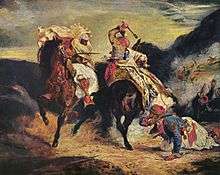The Giaour
|
The Combat of the Giaour and Hassan Painted by Eugène Delacroix (1826) | |
| Author | Lord Byron |
|---|---|
| Country | United Kingdom |
| Language | English |
| Genre | Romance/Epic poetry |
| Published | 1813 T. Davison |
| Media type | |
| Length: 458 lines | |
The Giaour is a poem by Lord Byron first published in 1813 by T. Davison and the first in the series of his Oriental romances. The Giaour proved to be a great success when published, consolidating Byron's reputation critically and commercially.
Background
Byron was inspired to write the poem during his Grand Tour during 1810 and 1811, which he undertook with his friend John Cam Hobhouse. While in Athens, he became aware of the Turkish custom of throwing a woman found guilty of adultery into the sea wrapped in a sack.
"Giaour" (Turkish: Gâvur) is an offensive Turkish word for infidel or non-believer, and is similar to the Arabic word "kafir". The story is subtitled "A Fragment of a Turkish Tale", and is Byron's only fragmentary narrative poem. Byron designed the story with three narrators giving their individual point of view about the series of events. The main story is of Leila, a member of her master Hassan's harem, who loves the giaour and is killed by being drowned in the sea by Hassan. In revenge, the giaour kills him and then enters a monastery due to his remorse. The design of the story allows for contrast between Christian and Muslim perceptions of love, sex, death and the afterlife.
The poem was written after Byron had become famous overnight after the publication of the first two cantos of Childe Harold's Pilgrimage and reflects his disenchantment with fame. It also reflects the gloom, remorse and lust of two illicit love affairs, one with his half-sister Augusta Leigh and the other with Lady Frances Webster.
The earliest version of the poem was written between September 1812 and March 1813, and a version of 700 lines published in June 1813. Several more editions were published before the end of 1813, each longer than the last. The last edition contains 1300 lines, almost twice as many as the version first published.
Romantic Orientalism
The Giaour proved to be very popular with several editions published in the first year. By 1815, 14 editions had been published when it was included in his first collected edition. Its runaway success led Byron to publish three more "Turkish tales" in the next couple of years: "The Bride of Abydos" in 1813, "The Corsair" in 1814 and "Lara". Each of these poems proved to be very popular, with "The Corsair" selling 10,000 copies in its first day of publication. These tales led to the public perception of the Byronic hero. The Giaour illustrates the idea of Orientalism with its characters.
Some critics consider Leila as a personification of Greece, for the sake of which there was a war between the Ottoman Empire and Russia.
Byron commented ironically on the success of these works in his 1818 poem "Beppo":
"Oh! that I had the art of easy writing,
What should be easy reading [...]
How quickly would I print (the world delighting)
A Grecian, Syrian or Assyrian tale
And sell you, mixed with Western sentimentalism,
Some samples of the finest Orientalism."
French painter Eugène Delacroix used the story as the inspiration of his 1827 painting Combat of the Giaour and the Pasha. So did Ary Scheffer who painted Giaour, housed at the Musée de la Vie romantique, Paris.
Importance
The poem was an influence on the early work of Edgar Allan Poe. His first major poem, "Tamerlane", particularly emulates both the manner and style of The Giaour.[1]
The theme of vampires
The Giaour is also notable for its inclusion of the theme of vampires. After telling how the giaour killed Hassan, the Ottoman narrator predicts that in punishment for his crime, the giaour will be condemned to become a vampire after his death and kill his own dear ones by drinking their blood, to his own frightful torment as well as theirs. Byron became acquainted with the concept of vampires while on his Grand Tour.
The association of Byron with vampires continued in 1819 with the publication of The Vampyre by John William Polidori, which was inspired by an unfinished story by Byron, "Fragment of a Novel", also known as "The Burial: A Fragment", first published in Mazeppa in 1819. The lead character, Lord Ruthven, was based on Byron. Polidori had previously worked as Byron's doctor and the two parted on bad terms. Much to Byron's annoyance, The Vampyre was widely attributed to him and even included in the third volume of Byron's works by popular demand. Polidori is thought to have encouraged this, seeing how it increased sales considerably. Lord Ruthven was the first portrayal of the vampire as a debauched aristocrat.
References
- ↑ Campbell, Killis. "The Origins of Poe", The Mind of Poe and Other Studies. New York: Russell & Russell, Inc., 1962: 150.
External links
| Wikisource has original text related to this article: |
- Text of The Giaour
- Norton anthology on 'The Giaour
- About.com article on vampire stories
- Crede Byron on Byron's association with vampires
- Library of Congress, Online Catalog
-
 e Giaour public domain audiobook at LibriVox
e Giaour public domain audiobook at LibriVox

.jpg)